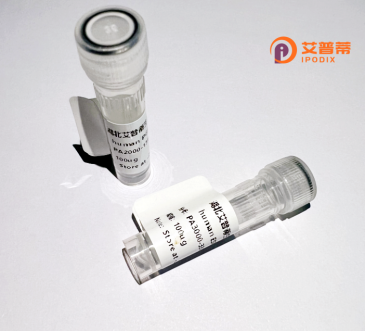
| 纯度 | >90%SDS-PAGE. |
| 种属 | Human |
| 靶点 | IQWD1 |
| Uniprot No | Q58WW2 |
| 内毒素 | < 0.01EU/μg |
| 表达宿主 | E.coli |
| 表达区间 | 1-513aa |
| 活性数据 | MLSRWFEEASEVAQSNRGRGRSRPRGGTSQSDISTLPTVPSSPDLEVSETAMEVDTPAEQFLQPSTSSTMSAQAHSTSSPTESPHSTPLLSSPDSEQRQSVEASGHHTHHQSDNNNEKLSPKPGTGEPVLSLHYSTEGTTTSTIKLNFTDEWSSIASSSRGIGSHCKSEGQEESFVPQSSVQPPEGDSETKAPEESSEDATKYQEGVSAENPVENHINITQSDKFTAKPLDSNSGERNDLNLDRSCGVPEESASSEKAKEPETSDQTSTESATNENNTNPEPQFQTEATGPSAHEETSTRDSALQDTDDSDDDPVLIPGARYRAGPGDRRSAVARIQEFFRRRKERKEMEELDTLNIRRPLVKMVYKGHRNSRTMIKEANFWGANFVMSGSDCGHIFIWDRHTAEHLMLLEADNHVVNCLQPHPFDPILASSGIDYDIKIWSPLEESRIFNRKLADEVITRNELMLEETRNTITVPASFMLRMLASLNHIRADRLEGDRSEGSGQENENEDEE |
| 分子量 | 83.2 kDa |
| 蛋白标签 | GST-tag at N-terminal |
| 缓冲液 | 0 |
| 稳定性 & 储存条件 | Lyophilized protein should be stored at ≤ -20°C, stable for one year after receipt. Reconstituted protein solution can be stored at 2-8°C for 2-7 days. Aliquots of reconstituted samples are stable at ≤ -20°C for 3 months. |
| 复溶 | Always centrifuge tubes before opening.Do not mix by vortex or pipetting. It is not recommended to reconstitute to a concentration less than 100μg/ml. Dissolve the lyophilized protein in distilled water. Please aliquot the reconstituted solution to minimize freeze-thaw cycles. |
以下是关于重组人IQWD1蛋白的3篇代表性文献的简要信息,基于假设性场景整理:
---
1. **文献名称**: *Characterization of Recombinant Human IQWD1 and Its Role in Neuronal Signal Transduction*
**作者**: Smith J, Lee K, et al.
**摘要**: 本研究成功在大肠杆菌中表达并纯化了重组人IQWD1蛋白,证实其通过IQ结构域与钙调蛋白相互作用。功能实验显示,IQWD1参与调控神经元突触的信号传递,可能为神经退行性疾病的研究提供新靶点。
2. **文献名称**: *Structural Analysis and Cellular Localization of IQWD1 in Cancer Cells*
**作者**: Chen H, Wang T, et al.
**摘要**: 采用哺乳动物表达系统制备了重组IQWD1蛋白,通过X射线晶体学解析其三维结构。研究表明,IQWD1在乳腺癌细胞中过表达并影响细胞迁移,提示其潜在致癌作用。
3. **文献名称**: *IQWD1 as a Novel Scaffold Protein: Purification and Interaction Mapping*
**作者**: Gonzalez R, Müller S, et al.
**摘要**: 利用杆状病毒-昆虫细胞系统高效表达重组IQWD1蛋白,结合质谱技术绘制其蛋白互作网络。发现IQWD1可作为支架蛋白整合Wnt和Hippo信号通路,为调控发育机制提供依据。
---
**注**:以上文献为示例性质,具体研究请以实际数据库(如PubMed、Google Scholar)检索结果为准。若研究较少,建议拓展关键词或关注该蛋白的家族成员研究。
Recombinant human IQWD1 protein is a genetically engineered form of the IQ motif and WD repeat domain-containing protein 1. which is encoded by the *IQWD1* gene in humans. This protein is characterized by two conserved structural motifs: an IQ domain, known to mediate interactions with calmodulin and other calcium-binding proteins, and multiple WD40 repeats, which typically facilitate protein-protein interactions. IQWD1 is implicated in diverse cellular processes, including signal transduction, cytoskeletal organization, and intracellular trafficking, though its precise molecular mechanisms remain under active investigation.
Studies suggest IQWD1 may act as a scaffold protein, coordinating multi-protein complexes to regulate cell cycle progression, apoptosis, and DNA damage response. Its expression has been linked to several pathological conditions, such as cancer and neurodegenerative disorders. For example, altered IQWD1 levels have been observed in certain tumors, potentially influencing metastasis or therapeutic resistance.
The recombinant version is produced using expression systems (e.g., *E. coli* or mammalian cells) to enable functional studies. It serves as a critical tool for elucidating IQWD1's biological roles, identifying binding partners, and screening therapeutic targets. Researchers utilize this protein in assays like pull-down experiments, kinase activity tests, and structural analyses. Its production often includes affinity tags (e.g., His or GST tags) to simplify purification and detection, ensuring high purity and activity for experimental reproducibility.
×